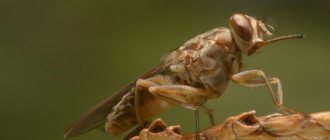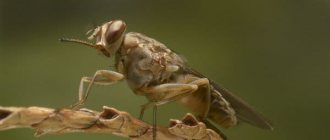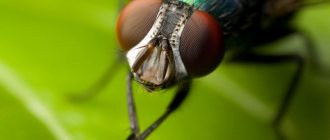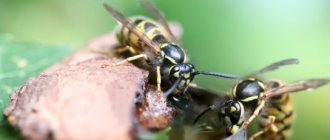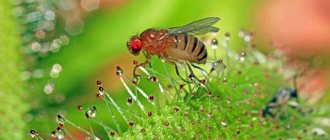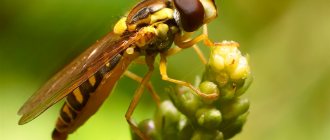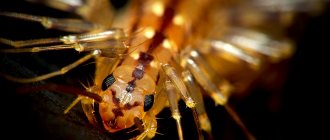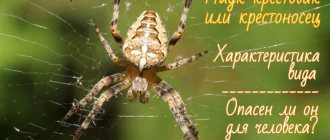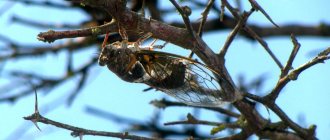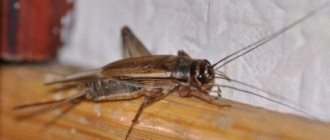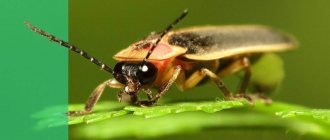The tsetse fly is a dangerous insect for humans. Because of its bites, about 50 thousand people die every year in African countries! Because of it, people are afraid to develop agricultural areas located near its habitat. To complicate the situation, the tsetse fly has a fairly long lifespan. The habitat area of this dangerous insect exceeds 10 million square meters of Africa! There are people living next to her who take risks every day, because at any moment they can fall ill with a deadly disease.
What does a tsetse fly look like?
Tsetse fly
The body of a tsetse fly consists of three parts: the head, thorax and abdomen. The size of individuals is 9-14 mm. The fly has large compound eyes of a dark brown color on its head. The organs of vision are clearly separated from each other.
The fly's thorax consists of three segments fused together. The tsetse fly is reddish-gray in color and has four brown longitudinal stripes on its back. Three pairs of legs and wings extend from the chest.
The insect's abdomen is short and wide. An insect can drink blood equal in size to its own weight. After she drinks blood, the abdomen increases in size. Females have a uterus in their abdomen; it is large in size and can accommodate a third instar larva.
The fly's mouthparts consist of a hard lower lip with a sharp tongue and an elongated upper lip. After it pierces the skin, the fly injects saliva into the victim, which prevents the blood from clotting.
The tsetse fly is different from a regular fly; it has the following characteristic features:
- hard proboscis directed forward;
- transparent wings with an axe-shaped vein pattern;
- short antennae with hairs, forked at the ends;
- wings folded one on top of the other at rest.
Life cycle
Tsetse has an unusual method of reproduction associated with abundant food supply. Technically, it goes through all the standard stages of insect development:
- egg;
- 3 larval stages;
- cocoon;
- Imago.
Life cycle of the tsetse fly
But only the latter can be seen. Until the last larval stage, the fly develops inside the female. During intrauterine development, the larva feeds on a milk analogue, which is secreted by a modified gland in the uterus. At the third stage, the larva leaves the female and immediately burrows into moist soil. It pupates in the soil.
The development of dolls lasts 20-30 days. The adult emerges from the cocoon and immediately flies off in search of a mate and food.
Interesting!
In Tsetse, both sexes drink blood.
Flies live for several years. The female fly only lays one larva at a time. In a year, he can lay only 4-6 offspring. But over the course of her entire life, the number of larvae reaches 31. A woman needs protein-rich, high-calorie food to live and feed her offspring. The tsetse belly is designed in such a way that a woman can drink as much blood as she weighs at one time.
Where does the tsetse fly live?
As already mentioned, the tsetse fly is found in Africa. It can be seen south of the Sahara, in the equatorial and subequatorial zones. The habitat of tsetse flies includes about 37 countries: Nigeria, Kenya, Uganda, Cameroon, Gabon, etc., and 32 countries from the entire list are the poorest in the world. The parasite prevents the development of fertile lands, which slows down the development of the state’s economy. For this reason, scientists are trying to find a way to destroy the tsetse fly, but so far without success.
The widespread spread of the tsetse fly began in 1887. The plague virus was brought from Europe to Africa and led to mass deaths of local residents, livestock and wild animals. As a result, many pastures were abandoned, overgrown with bushes and became ideal habitat for the tsetse fly. Insects have settled in many areas of Africa where they were not previously found. The spread of tsetse flies was accompanied by the infection of people with sleeping sickness, resulting in millions of deaths.
Areas where tsetse flies live are currently free of people. There are national wildlife parks there.
Notes[ | ]
- Aksoy S.
Wigglesworthia gen.
Nov. And Wigglesworthia glossinidia
sp. nov., Taxa Consisting of the Mycetocyte-Associated, Primary Endosymbionts of Tsetse Flies (English) // International Journal of Systematic Bacteriology (English) (Russian: Journal - 1995. - Vol. 45, no. 4. - P. 848-851. - doi:10.1099/00207713-45-4-848. - PMID 7547309. - Akman, Leyla;
Yamashita, Atsushi; Watanabe, Hidemi; Oshima, Kenshiro; Shiba, Tadayoshi; Hattori, Masahira; Aksoy, Serap. Genome sequence of the endocellular obligate symbiont of tsetse flies,
Wigglesworthia glossinidia
(English) // Nature Genetics: Journal. - 2002. - Vol. 32, no. 3. - P. 402. - doi:10.1038/ng986. - PMID 12219091. - Nogge G.
Sterility in tsetse flies (
Glossina morsitans
Westwood) caused by loss of symbionts (English) // Experientia: Journal. - 1976. - Vol. 32. - P. 995−996. - ↑ 1 2
Book: There is no place for wild animals
(unspecified)
. www.e-reading.club. Access date: November 29, 2015. - Tsetse // Great Soviet Encyclopedia: [in 30 volumes] / ch. ed. A. M. Prokhorov. — 3rd ed. - M.: Soviet Encyclopedia, 1969-1978.
- How did Africa get rid of the tsetse fly?
- Ethiopia carries out mass sterilization of tsetse flies
- Pape T., Blagoderov V. & Mostovski MB
Order Diptera Linnaeus, 1758. In: Zhang Z.-Q. (Ed.) Animal biodiversity: An outline of higher-level classification and survey of taxonomic richness (English) // Zootaxa. - 2011. - No. 3148. - P. 222-229. — ISSN 1175-5334. - Laveissière C., Grébaut S.P., Herder S. Penchenier L.
Les glossines. vectrices de la Maladie du Sommeil. - Yaoundé, 2000. - pp. 35-42. — 257 p. - Pont A.
Family Glossinidae // Catalog of the Diptera of the Afrotropical Region / Crosskey RW (ed.). - London: British Museum (Natural History), 1980. - P. 762–765. — 1437 p. - Fossil Diptera Catalog - Glossinidae (undefined)
. hbs.bishopmuseum.org. Date accessed: December 6, 2022. - Glossina (English) information on the Paleobiology Database website. (Accessed: December 6, 2018).
Lifestyle of the tsetse fly
Tsetse flies have different lifestyles, which depend on their species:
- Glossina palpalis lives in forests and bushes located near water bodies. They bite reptiles and humans;
- Glossina fusca live in the depths of tropical forests, choosing areas with moderate temperatures and high humidity. She doesn't bite people;
- Glossina morsitans can be found in the savannahs of South Africa. The insect bites wild ungulates, domestic cattle and people.
Most of the tsetse fly's life cycle is the adult state. Adults live for 6-7 months. A comfortable habitat for the tsetse fly is high humidity. If the dry season begins, insects accumulate near water bodies and hide under leaves. In such conditions they practically do not fly.
Tsetse flies find food easily because the animals come to drink. If in ordinary mosquitoes only females feed on blood, then in tsetse flies there are both females and males, and they feed often.
Tsetse flies attack people, artiodactyls, horses and various predators. At the same time, tsetse flies do not bite zebras, because insects do not perceive black and white coloring.
The insect is especially attracted to dark colors, so dark-skinned people and animals with black skin are at greater risk.
The danger of the tsetse fly lies in the fact that it flies quickly and silently, and in addition, it is highly durable. Even hitting the fly and damaging its wings will not stop it; the insect will again try to attack the victim.
Classification[ | ]
The genus includes from 22 to 31 species, which are grouped into three subgenera[8][9][10]:
- Austenina Towensend, 1921 Glossina (Austenina) brevipalpis Newstead, 1910
- Glossina (Austenina) frezili Gouteux, 1987
- Glossina (Austenina) fusca (Walker, 1849)
- Glossina (Austenina) fuscipleuralis Austen, 1911
- Glossina (Austenina) haningtoni Newstead & Evans, 1922
- Glossina (Austenina) nigrofusca Newstead, 1910
- Glossina (Austenina) longipennis Corti, 1895
- Glossina (Austenina) medicorum Austen, 1911
- Glossina (Austenina) nashi Potts, 1955
- Glossina (Austenina) schwetzi Newstead & Evans, 1921
- Glossina (Austenina) tabaniformis Westwood, 1851
- Glossina (Austenina) severini Newstead, 1913
- Glossina (Austenina) vanhoofi Henrard, 1952
- Glossina (Glossina) austeni Newstead, 1912
- Glossina (Nemorhina) caliginea Austen, 1911
How do tsetse flies reproduce?
Insects mate only once. After fertilization, females do not lay eggs, as many insects do, but carry them in a special sac in the abdomen. The larvae develop one at a time. In total, the female brings about 8-10 larvae during her life.
While the larvae are in the body of the fly, they feed on the secretions of a special gland. The development of the offspring in the female's body takes about 1-2 weeks, then they are born. The larvae do not live long outside the mother's body, since they are born already at the last stage of the larval life cycle.
A few hours after hatching, the larva burrows into the soil to a depth of 2-3 cm and turns into a pupa. The body of the pupa is dark brown or black, its length is 1 cm. The larva remains in this phase for about 3-4 weeks.
Due to the nutritional value of the blood, the larva and pupa do not need additional food. They develop using reserves made at the imago stage.
Reproduction
Tsetse is a viviparous species of insect, since the embryo initially develops in the uterus of the female. During its life cycle, a tsetse reproduces from 8 to 10 offspring. Mating in a female occurs once. After about 8-9 days, a fertilized egg appears. The larva lives in the uterus of the female, where it grows due to maternal nutrients.
The tsetse fly must take blood three times for the larva to develop normally. If the female fails to eat, the larval embryo dies.
With normal development of the larva, after a nine-day period, it transforms into a pupa, burrowing into a layer of earth. Then the hard outer film of the puparia develops. The pupa develops in three weeks. It has a hard shell with an oblong shape. It contains dark petals with a breathing tail. The pupa is less than one centimeter long.
A fly forms from the shell within a month. After two weeks, the fly can already mate and begins to lay larvae. The period between the birth of a female and her reproduction of the first larva is fifty days. Throughout her life, every nine days, the female tsetse produces a larva.
Why is the tsetse fly dangerous? Sleeping sickness: symptoms, treatment
Tsetse fly bite
The tsetse fly is incredibly dangerous not only for animals, but also for people. She is a carrier of deadly parasites - trypanosomes and nagana. Glossina palpalis is considered the most dangerous species; it is most often the carrier of African trypanosomiasis, better known as sleeping sickness.
Parasites enter the body of a fly when it drinks the blood of a sick animal, then they multiply in the stomach and enter the salivary glands of the proboscis. It takes an average of 18 days for the parasite to develop, the exact period depends on the air temperature.
When a fly infected with parasites bites an animal or person, it transmits trypanosomes in its saliva, which enter the victim's blood.
Symptoms of revolver in animals
Once an animal is bitten by an infected tsetse fly, it may develop Nagana disease.
In animals, the symptoms of revolver occur as follows:
- performance decreases;
- the number of spontaneous abortions is increasing;
- milk and meat production decreases;
- annual mortality - up to three million heads.
Cattle, pigs and horses are at risk.
You can protect animals from this terrible disease by making a vaccine against trypanosomiasis. But the problem is that not all farmers have the opportunity to vaccinate thousands of heads of livestock.
Sleeping sickness symptoms
The causative agent of sleeping sickness is trypanosome, a single-celled protozoan measuring 20-30 microns. You can become infected with sleeping sickness only through an insect bite.
Sleeping sickness affects the nervous and immune systems.
When infected, a lump appears at the site of the victim’s bite, which causes pain when pressed. The diameter of this swelling is about 1-2 cm.
Main symptoms of sleeping sickness:
- increased temperature or fever;
- joint pain;
- sleep disturbance;
- numbness of hands and feet;
- problems with coordination;
- confused consciousness.
Chancres, similar to boils, appear on a person’s hands or feet. After a few weeks, they heal, leaving only scars on the skin. Afterwards, headache and fever begin, and if treatment is not started, trypanosomes attack the brain.
Types of sleeping sickness
There are two types of trypanosomiasis: African and Latin American.
African is divided into two more types:
- West African (Gambian) sleeping sickness.
This disease progresses slowly and for a long time. It is carried by Glossina palpalis. The disease is divided into two periods, the first lasts from 1 to 5 years. At this stage, a person suffers from headaches, fever, erythematous rashes, and enlarged occipital lymph nodes. The latent course of the disease, without any acute symptoms, leads to the disease becoming advanced.
The second stage is more acute: the patient’s limbs begin to tremble, severe drowsiness appears, paralysis is possible, the nervous system begins to collapse, and mental disorders appear. The second stage lasts about 7-8 months.
- Eastern (Rhodesian) sleeping sickness.
This type of disease progresses quickly and is characterized by pronounced symptoms. The vector of the disease is Glossina morsitans. This type of sleeping sickness affects the brain and heart and leads to death after six months.
Treatment of sleeping sickness
Tsetse fly bite
To diagnose the disease, a blood and lymph node fluid test is performed. If it is possible to identify the first stage of the disease, when the nervous system is not affected, then the treatment is quite quick and effective.
There are special drugs that can destroy parasites: pentamidine and suramin.
Treatment of the disease in the second stage is much more difficult. Doctors use potent drugs (for example, melarsoprol), which have many side effects, including nausea, increased blood pressure, arrhythmia, etc. The difficulty of treatment lies in the fact that the protozoan parasite constantly mutates and becomes resistant to drugs.
There are about 70 million people in Africa who can become infected with sleeping sickness at any time. The risk zone also includes tourists coming to this exotic continent.
If you suddenly have even the slightest suspicion of a tsetse fly bite, you should immediately go to the hospital. Timely detection of the disease gives a high chance of complete recovery without any complications.
Before traveling to Africa, tourists are advised to get a pentamidine vaccine. You should also remember about safety precautions: wear white, wear a net over your face and apply repellent.
Population and species status
Photo: tsetse fly insect
The tsetse fly inhabits almost 10,000,000 km2 of mostly tropical forest, and many parts of this large area are fertile land that remains uncultivated - a so-called green desert, unused by people and livestock. Most of the 39 countries affected by tsetse flies are poor, indebted and underdeveloped.
The presence of tsetse flies and trypanosomiasis prevents:
- Use of more productive exotic and cross-breeding cattle;
- Suppresses growth and affects livestock distribution;
- This reduces the potential for livestock and crop production.
Tsetse flies transmit a similar disease to humans called African trypanosomiasis or sleeping sickness. An estimated 70 million people in 20 countries are at varying levels of risk, with only 3-4 million people under active surveillance. Because the disease typically affects economically active adults, many families remain far below the poverty line.
A better understanding of how the tsetse fly interacts with its microbiota will allow the development of new and innovative management strategies aimed at reducing tsetse fly populations.
The joint program has been developing SIT for the most important tsetse fly species for several decades. It has been used effectively in cases where natural populations have been reduced through trapping, insecticide-impregnated targets, livestock treatments, and aerial application of sequential spray painting techniques.
The spread of sterile males over an area over many generations of flies can eventually wipe out individual tsetse fly populations.
How to get rid of tsetse flies?
As already mentioned, scientists are trying to find a way to destroy insects, but so far they have not succeeded.
To combat the tsetse fly in the 20th century, the following methods were used:
- Scorched earth. To do this, they killed all the livestock that the tsetse fly fed on. Because of this, the insects died. But this method was effective only in the short term; in the long term it turned out to be useless, because the fly fed not only on large animals, but also on reptiles and rodents.
- Deforestation. This method also cannot be called effective. As the name suggests, it involved cutting down forests so that the tsetse fly would lose its usual living conditions. But it is obvious that this method only brings harm, not benefit.
- Use of pesticides. To do this, special preparations were sprayed from airplanes and applied to animals. But the method did not bring the desired effect.
- Setting traps. A simple mechanical method gives good results. To make a trap, you need to take dark cloth or buffalo hide and soak it with insecticides. To attract flies, an artificially created smell is used, reminiscent of an animal's breath or urine. This method helped reduce the tsetse fly population.
- Sterilization of males. At the moment, the method is the most effective. To sterilize the males, they were irradiated with radiation and released into places where insects were crowded. After mating, the females were unable to produce offspring, and their eggs remained unfertilized. This method was especially effective in Zanzibar. Its disadvantage is the lack of a water barrier with neighboring states, as a result of which healthy males entered the region, and tsetse flies multiplied again.
The tsetse fly is a terrible insect that causes serious harm to animals and people. But at the same time, there are people who believe that the insect is necessary. In particular, wildlife conservationist Bernhard Grzimek believes that the tsetse fly protects pristine nature from the invasion of civilization.
Interesting facts
An amazing insect, feeding exclusively on blood and capable of destroying thousands of living beings, could not help but become the object of meticulous research, during which a huge amount of interesting information was revealed. Interesting facts about the insect:
- The name sounds strange and nonsensical to most peoples, but in the language of the African aborigines, tsetse means “cattle slaughterer.”
- Half a million people living in sub-Saharan Africa are infected with trypanosomes as a result of the bite of Glossina.
- The fact that the tsetse fly is a carrier of some kind of disease was known back in the middle of the 19th century, but the mechanism of the disease began to be thoroughly studied only at the beginning of the last century.
- More than 3 million heads of livestock suffer annually from insect bites and up to 10 thousand people die.
- In 1934, Howard Lovecraft created a story called “The Winged Death,” which describes the death of a man from the bite of a “devil fly” and the subsequent transmigration of the victim’s soul into the body of an insect. According to the protagonist, “the bite of such a fly means certain death for everyone and everything within seventy-five days.”
- A fly that smells prey strives to drink blood at any cost - even if you stun the tsetse or break its wings, the insect will still make attempts to get to its victim.
- In the 40s of the last century, strong insecticidal preparations were invented to combat Glossina, but their use had to be abandoned - the substances posed a significant threat to the environment.
- Among programmers, “tsetse” is the name for a problem that occurs when a Seagate hard drive fails and is displayed in the LED error code: 00CC FAddr:024A051.
Insects of the genus Glossina are deadly, so before visiting exotic African countries you should definitely undergo the vaccination procedure and stock up on all necessary medications, and if bitten, immediately seek medical help.
Current distribution of the disease
Prevalence rates of the disease vary between countries, as well as between areas within a given country.
- Over the past 10 years, more than 70% of cases have been reported in the Democratic Republic of the Congo.
- Angola, Cameroon, Central African Republic, Chad, Congo, Guinea, Malawi, South Sudan and Zambia reported between 10 and 100 new cases in 2022, while Côte d'Ivoire, Equatorial Guinea, Gabon, Uganda, United The Republic of Tanzania and Zimbabwe – from 1 to 10 new cases.
- Over the past 10 years, isolated cases have been reported in countries such as Burkina Faso, Ghana and Nigeria.
- Benin, Botswana, Burundi, Ethiopia, Gambia, Guinea-Bissau, Liberia, Mali, Mozambique, Namibia, Niger, Rwanda, Senegal, Sierra Leone, Eswatini and Toga have reported no new cases in the past 10 years. In some of these countries, transmission appears to have stopped, but it is difficult to accurately assess the real situation in some areas because surveillance and diagnosis are hampered by social instability and/or difficulties in accessing the population.
Public-private partnerships
In 2000 and 2001 WHO established a public-private partnership with Aventis Pharma (now Sanofi) and Bayer HealthCare, resulting in a WHO-led disease surveillance and control program that provides control support to endemic countries at no cost to medicines are supplied.
The partnership has been renewed several times in 2006, 2011, 2016 and 2021. Progress in reducing the incidence of sleeping sickness and the prospect of its elimination has prompted a number of other private sector partners to support the WHO initiative to eliminate the disease as a public health problem and ensure the elimination of transmission by 2030 G.
First aid
Multiple injuries are the most painful: if the legs, arms, stomach and other parts of the body are bitten by a fly, inflammation develops. The bite causes swelling of the soft tissues and can worsen overall health. Wounds are treated with an antiseptic - green, alcohol, iodine.
What is the best way to treat child bites? In this case, non-alcoholic products can help - chlorhexidine, hydrogen peroxide. In addition, soothing and cooling ointments help with a bite, which reduces the occurrence of local reactions. To prevent fly bites from causing allergies in children, Zodak drops or Diazolin for children are given.
Population
The tsetse fly spreads over a huge area of ten million square kilometers. These lands are fertile, but are not cultivated or used for grazing. The countries where the tsetse fly lives have no development and are very poor. Animal husbandry and agricultural production are not developed.
Tsetse infects people with a disease called African trypanosomiasis. Epidemic surveillance is carried out on approximately four million people in flight zones, which are home to 70 million Africans.
For decades, people have been fighting tsetse flies. This led to a reduction in the natural population. The eradication of the limited population of tsetse flies is facilitated by male irradiation and their spread through contaminated areas.
Scientists believe that declining tsetse populations do not harm the ecosystem at all. The implementation of insect control devastates regions that become lifeless. The fly is wiping out populations, starving to death and damaging the economies of African countries.
Disease management: making a diagnosis
Disease management is carried out in three stages:
- Screening for possible infection. This includes serological testing (only available for Tb gambiense) and testing for clinical signs, particularly enlarged cervical lymph nodes.
- Search for parasites in biological fluids.
- Determining the stage of the disease. This involves a clinical examination of the patient and, in some cases, examination of cerebrospinal fluid obtained by lumbar puncture.
To avoid the need for complex and difficult treatment methods, diagnosis should be performed as early as possible before the development of the neurological stage of the disease.
Due to the long and asymptomatic course of the first stage of sleeping sickness caused by T. b. gambiense, careful and active screening of risk groups is recommended in order to identify patients at an early stage of the disease and limit further spread of infection through their treatment, after which they cease to act as a reservoir. Comprehensive population screening requires significant financial investment in human and material resources. In Africa, especially in remote areas where the disease is most prevalent, these resources are often in short supply. As a result, some infected people die before being diagnosed and receiving treatment.
Major epidemics
Several epidemics have occurred in Africa over the past century:
- the epidemic of 1896-1906, mainly affecting Uganda and the Congo River basin;
- the 1920 epidemic that affected a number of African countries; And
- the most recent epidemic, which began in 1970 and continued until the end of the 1990s.
In 1920, the epidemic was fought with mobile teams that screened millions of people living in high-risk areas. By the mid-1960s. the spread of the disease was brought under control, with fewer than 5,000 cases reported throughout the continent. Following this success, surveillance was relaxed, causing the disease to return, and by 1970, outbreaks had grown to epidemic levels in several regions. In the 1990s. and at the beginning of the 21st century, thanks to the efforts of WHO, the implementation of national programs to combat the disease, bilateral cooperation and the activities of non-governmental organizations (NGOs), the upward trend in incidence was stopped.
As the number of new cases of human African trypanosomiasis decreased significantly between 2000 and 2012 as a result of international coordinated efforts, the WHO Roadmap for Control of Neglected Tropical Diseases set a goal for its elimination as a public health problem by 2022 and elimination transmission (reducing the number of cases to zero) by 2030.
